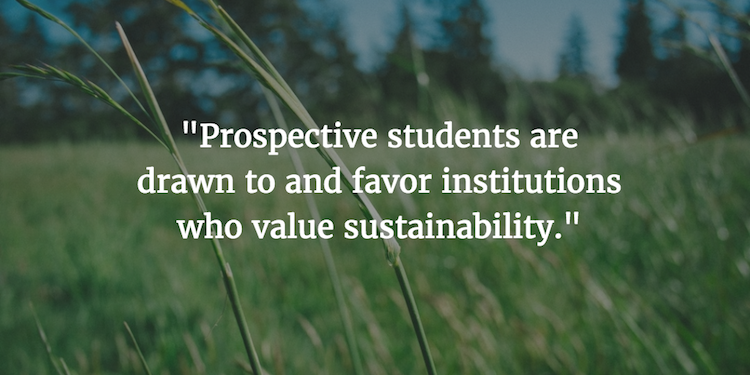Climate change is a major topic of conversation in society today.
The effects of our consumption choices are being felt by people globally and compounded annually. We need to continue our united and concerted efforts to counteract the impact we’ve made on the environment.
In honor of Earth Day and the upcoming People’s Climate March, we wanted to discuss the importance of thinking sustainably.
Colleges and universities have shown themselves to be forward thinking when it comes to being “green”. Whether it is through major campus-wide initiatives at places like Unity College, Dickinson College, or University of New Hampshire (among many others), or fossil fuel divestment efforts at institutions all over the world, colleges and their students alike understand that they can be leaders on this issue. Prospective students are drawn to and make admissions decisions around institutions who value sustainability. If that’s not enough, then consider that simple changes to use less can help you save money in the long run. So do it for the planet, and if not that, do it for your bottom line.

Here are ideas for your campus to help save the planet while saving money:
- Organize donation drives. This can be a free (or very inexpensive) way to engage students in service and sustainability. You can drop off donations yourself and use old boxes to transport them. Yale University just finished up their Declutter, Destress, Donate drive where students are encouraged to take a break and declutter their space. Extra items they no longer need can either go to other departments on campus or can be dropped off on-campus to donate to Easter Seals Goodwill. Decluttering spaces helps students sleep better, focus better, and be more at peace with other distractions in their life.
- Use energy efficient lighting. Ask students to purchase LED lighting if they choose to bring their own lamps to their residence hall (hint: include it as part of a checklist). LED’s are known to last longer (25,000 hours) and use little energy. Whether it is on a smaller scale as desk lamps or larger scale with motion sensor hallway lights, this is something that can add up and give a great return on the investment.
- Move administrative procedures online. Using technology to move from paper procedures and communication can reduce waste (and costs) and increase efficiency. It’s a win-win! For example, student engagement platforms can eliminate the need for paper budgeting request forms, online waivers, and additional approval processes. Student organizations and student leaders will thank you later.
- Reuse old supplies. You don’t need to reinvent the wheel every time you put on a program or make a bulletin board. Hold on to supplies that can be reused or repurposed so you don’t have to keep buying things you only use once. If you have extra school supplies, markers, crayons, at the end of the year that have been untouched (and you get a brand new budget next year), consider donating them to a service abroad trip or a local school system.
- Organize carpools. There are some great tools to get this organized on your campus. This can help with traffic, parking issues, and community engagement as your students help give each other rides! The retention of students will help give a return on this sustainable investment. Florida International University recently implemented NuPark, an on-demand carpooling smartphone app to optimize parking and reduce student’s carbon footprint. Now students can park closer to classes and can share rides, reducing cost of getting to campus and meeting some new friendly faces!
- Utilize reusable bags, cups, containers when possible. How many cups, plates, etc. are thrown out on your campus goes through in a week, month, and year? Investing in branded reusable supplies helps build campus pride and also may help your bottom line since you don’t have to perpetually buy single use items. The planet will thank you for it.
- Incentivize less consumption. There are great programming ideas like “Kill A Watt” that fosters competition between residence halls to see who can use the least electricity, or to see who can produce the least garbage (or most recycling). Which takes me to my next point…
- Reduce food waste & compost. Controlling portion size and getting rid of trays at dining halls helps to reduce food waste in the long-run (and how much food you need to order in the first place) since most students will take more than they actually need. Also, instead of throwing leftover food away, compost it or send it to farms to use to feed their animals. Roger Williams University takes leftover meals and donates them to local women’s shelters and food pantries in their community.
Your Thoughts!
Climate change is a big, ill-structured problem and institutions have the choice to be a part of the solution. It is going to require all of us doing our part changing our habits and making small and big changes a priority.
We can foster a sustainability mindset with students while we have them as part of the campus community. It is the right thing to do for the planet, for the future, and we can help save money in the long run too. Whatever works best for your institution, it doesn’t matter what it is, as long as you do it and stay consistent.
What is your campus planning for Earth Day?
How do you support sustainability year round?
Let us know! Tweet @themoderncampus & @highered_geek and share your ideas!





